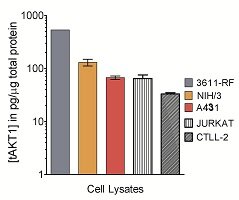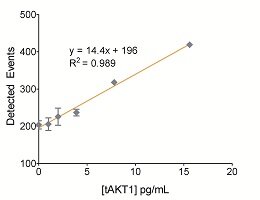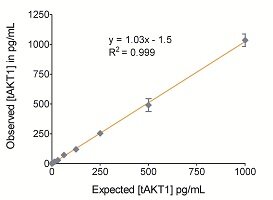Erenna® tAKT1 Immunoassay Kit (Cat# 03-0099-xx)
The Erenna® tAKT1 Immunoassay uses a quantitative fluorescent sandwich immunoassay technique to measure tAKT1 in human plasma samples. A capture antibody specific for human tAKT1 has been pre-coated onto paramagnetic microparticles (MPs). The user pipettes MPs, standards, and samples into uncoated microplate wells. During incubation, the tAKT1 present in the sample binds to the capture antibody on the coated MPs. Unbound molecules are washed away during the subsequent buffer exchange and wash steps. Fluor-labeled detection antibody is added to each well and incubated. This detection antibody recognizes and binds to tAKT1 that has been captured onto the MPs. During the following wash step the MPs are transferred to a clean plate. Elution buffer is then added and incubated. The elution buffer dissociates the bound protein sandwich from the MP surface, releasing the labeled antibodies. These antibodies are separated during transfer to a final microplate. The plate is loaded into the Erenna® System where the labeled molecules are detected and counted. The number of fluor-labeled detection antibodies counted is directly proportional to the amount of tAKT1 present in the sample when captured. The amount of tAKT1 in unknown samples is interpolated from a standard curve.
Assay Performance
| TABLE 1. Analytical sensitivity of the Erenna® tAKT1 Immunoassay Kit1 | |
| Lower Limit of Detection | 2.5 pg/mL |
| Lower Limit of Quantification2 | 7.8 pg/mL |
| Upper Limit of Quantification | 1000 pg/mL |
| Low-end CV% Range | 2-15% |
| Low-end CV% Average | 10% |
| Recommended Sample Volume | 100 µL |
| 1 See product insert for updated values 2 LLoQ ≤ 20% CV and ± 20% recovery | |
FIGURE 1. Mean endogenous [tAKT1] measured in human, rat and mouse tissue lysates.

FIGURE 2: The Erenna® tAKT1 Immunoassay Kit low-end standard curve.

FIGURE 3: The Erenna® tAKT1 Immunoassay Kit correlation curve.

Representative data shown for demonstration purposes only. Individual results may vary depending upon samples tested and protocol used.
Biology and DiseaseThe serine-threonine protein kinase AKT family is the primary downstream mediator of the phosphatidylinositol-3-kinase (PI3K) signaling pathway. Members of the family (AKT1, AKT2, and AKT3) require two separate kinases for complete activation. AKT1 phosphorylates mTOR, whose downstream targets include other kinases, cell cycle regulators, and transcription factors that are essential for many cell proliferation and survival processes. AKT1 also up-regulates matrix metalloproteinases and is thus implicated in tumor progression. AKT1 and other members of the AKT family have been an important focus in therapeutic development with their broad effects on the PI3K pathway.
| TABLE 2. Additional UniProtKB/Swiss-Prot Information* | |
| Protein Name: | AKT1 |
| UniProtKB/Swiss-Prot ID: | P31749 |
| Protein-protein interaction database: | P31749 |
| Alternative Names: | Protein Kinase B, RAC-PK-alpha |
| Gene Names: | AKT1 |
| Synonym Gene Names: | PKB, RAC |
| Function: | AKT1 is one of 3 closely related serine/threonine-protein kinases (AKT1, AKT2 and AKT3) called the AKT kinase, and which regulate many processes including metabolism, proliferation, cell survival, growth and angiogenesis. This is mediated through serine and/or threonine phosphorylation of a range of downstream substrates. |
| Biological Processes: | G-protein coupled receptor signaling pathway |
| Molecular Function: | Protein kinase activity |
| * Source Info from www.uniprot.org. | |
The website contains the most current versions of Singulex reagent Package Inserts. The current version may include minor updates to the reagent product or related protocols. Please refer to the Package Insert included with your reagent kit to ensure you are following the correct protocol for your product.
| Analyte | Description |
| AKT1, phospho Ser p473 | Erenna® pAKT1 (pSer473) Immunoassay Kit |
Need to request a quote? Ready to order?
Contact our Life Science customer support with your desired catalog number:
Email:
Tel: 510.995.3880
Toll Free: 888.995.6955
Fax: 510.995.9090